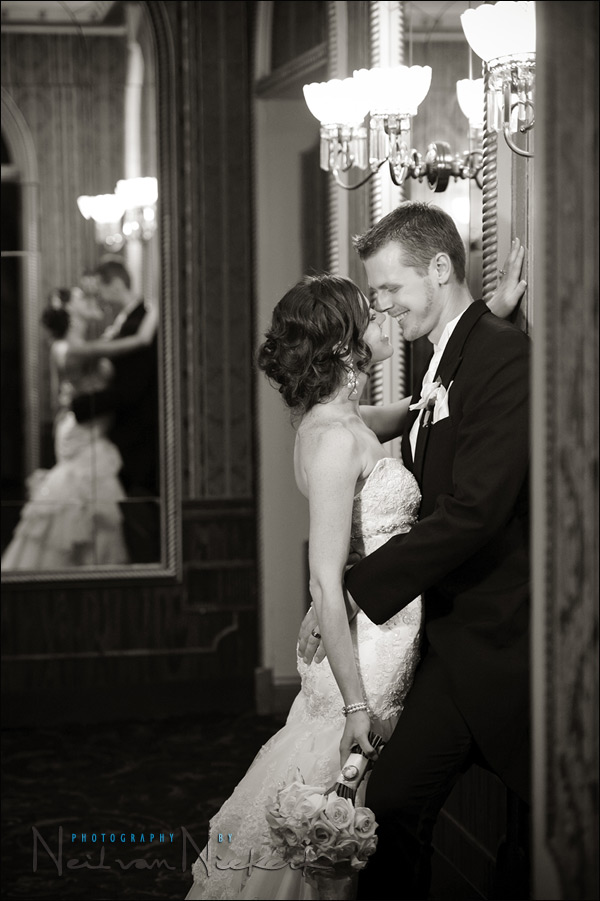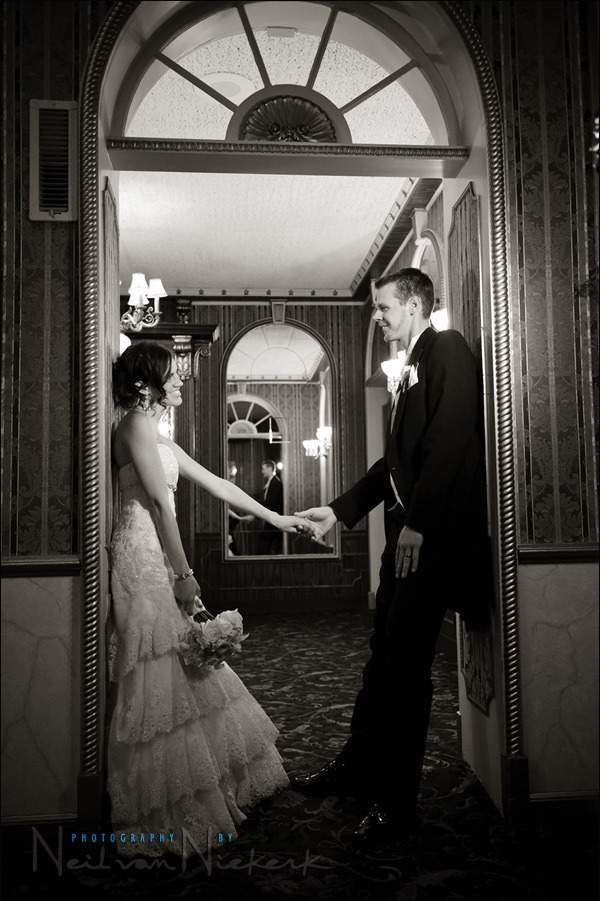
Romantic wedding portraits with video light
By now it should be clear that I’m quite a fan of video lights for the romantic portrait session with a couple. The Incandescent WB of the video light usually matches the existing light fairly well. Because video light has a rapid fall-off in light intensity to the edges of the beam, it doesn’t “flatten” out the light like bounce flash would. In addition, the video light can seem quite natural in context of the existing light, and not even look like additional lighting. Somehow the light just appears to be great right there.
Here are two images from the wedding at Shadowbrook, NJ, where I had my assistant hold up an LED video light to help light the couple. (It’s the same wedding where I used the black foamie thing during the indoor ceremony to bounce the flash forward without getting that hard direct flash look.)
image details:
- 1/60 @ f2.8 @ 1600 ISO … with video light; no flash
- Nikon D3; Nikon 70-200mm f2.8 AF-S VR II … used at 90mm
- recommended LED video light

image details:
- 1/60 @ f3.2 @ 1600 ISO … with video light; no flash
- Nikon D3; Nikon 24-70mm f2.8G AF-S … used at 35mm
- recommended LED video light
I have both the Lowel ID-Light (affiliate) and two LED video lights. Even though the Lowel ID-light is a better tool, the LED video light is my first choice for a quick-grab, always-ready light. LED video lights are compact, and use AA batteries. Easy to slip into your camera bag.
Now, if I had wanted to ease the contrast a bit, and bring in more shadow detail, it would be a simple matter of bouncing my on-camera flash behind me. But it would have to be with the FEC turned way down to -3EV so that it just acts as a fill light. The flash would also have to be gelled with a CTS or CTO gel then to not bring in a blue tint to the fill-light.
With the romantic portrait session at a wedding, I like to mix it up – some available light (if there is enough), some bounce flash, and some video light … or a mix of any of these. We have options.
Loved the first shot! :)
Love the photos! I second shot a wedding this past weekend and kept waffling back and forth as to whether I wanted to put my video light in my bag. I left it home and was sorry, (The main photographer didn’t have one either). I will always have it with me from here on out.
Awesome shots! I like the last one best – you can feel the happiness.
Great lighting! I really like the B&W aspect of it, too (and that takes care of any white balance issues, for sure). I’ve never used video lighting; do you have it on a stand? How much does it weigh and how far away can you use it (from the subject)? Guess I could just click on those provided links in the post and find out:)
Hi Neil. Did you use 2 video lights on the second shot?
These look great, did you use a grid on the video light?
The 2 light question is a good one. I thought it was one, with light from camera right based on the light spilling on the inside of the door frame. But then I noticed that the Groom has a shadow behind his head from a light source opposite him. I give. How’d you do it?
Neil I love these shots especially the first one with the reflection in the mirror. Did you have to take any special measures to ensure the video light did not reflect in the mirror?
Tony … it’s mostly just angling myself and my assistant so that I don’t get either of us in the mirror reflection. There was one image where I had to clone out my assistant’s hand holding the light. Here’s the original image and edit.
Really nice shots and great reflections, although I prefer to have the female against the wall so her face is the focal point instead of the grooms.
I usually prefer the bride against the wall, but your photo works.
Good job
Nick
Hi Neil,
Have you ever shot an entire wedding party with these lightpanels? They look very compact so I’m not sure it’s advisable. Looking for a more portable and less bulky solution.
Always inspired by your work Neil.
Much in the same vain as using flash do you establish the ambient exposure first (to your taste) and then add the video light to expose ‘correctly’ for your subject? How do you meter for this video light and therefore adjust the light power to the right level? By chimping on test shots?
Scott